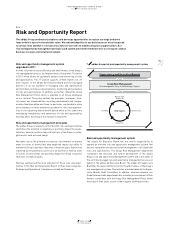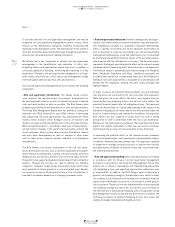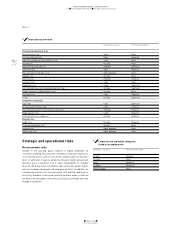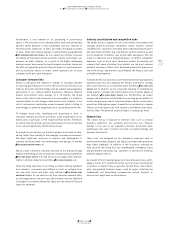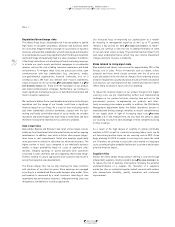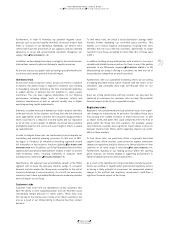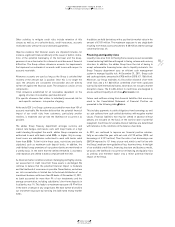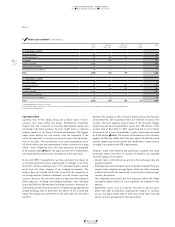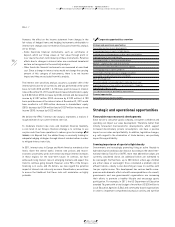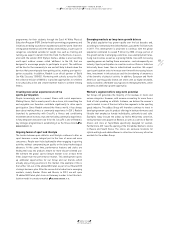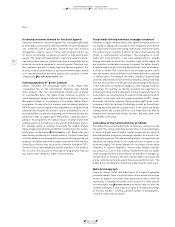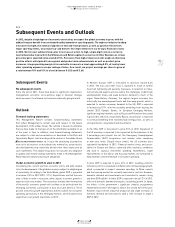Reebok 2011 Annual Report Download - page 158
Download and view the complete annual report
Please find page 158 of the 2011 Reebok annual report below. You can navigate through the pages in the report by either clicking on the pages listed below, or by using the keyword search tool below to find specific information within the annual report.
adidas Group
2011 Annual Report
GROUP MANAGEMENT REPORT – FINANCIAL REVIEW
154
2011
03.4 Risk and Opportunity Report Compliance-related risks Financial risks
03.4
Risks related to product counterfeiting and imitation
As popular consumer brands which rely on technological and design
innovation as defining characteristics, the Group’s brands are
frequent targets for counterfeiting and imitation. To reduce the loss
of sales and the potential damage to brand reputation resulting from
counterfeit products, the adidas Group makes use of extensive legal
protection (generally through registration) and works closely with law
enforcement authorities, investigators and external legal counsel.
Although we have stepped up measures such as product security
labelling with our authorised suppliers, the development of these
measures remains a key priority on an ongoing basis. In 2011, around
12 million counterfeit adidas Group products were seized worldwide.
As a result of our relentless and intensive efforts against counter-
feiting, we believe the risks related to counterfeiting and imitation
have decreased, and we now regard the likelihood of occurrence
as probable. However, we continue to assess the potential financial
impact related to counterfeiting and imitation as moderate.
Product quality risks
The adidas Group faces a risk of selling defective products, which may
result in injury to consumers and/or image impairment. We mitigate
this risk by employing dedicated teams that monitor the quality of our
products on all levels of the supply chain through rigorous testing
prior to production, close cooperation with suppliers throughout the
manufacturing process, random testing after retail delivery, open
communication about defective products and quick settlement of
product liability claims when necessary. In 2011, we did not recall any
products.
As product quality requirements are becoming increasingly stringent,
we believe the likelihood of occurrence of significant product liability
cases or having to conduct wide-scale product recalls has increased
to likely. However, we continue to assess the potential financial impact
as moderate.
Risks related to non-compliance
We face the risk that our employees breach rules and standards that
guide appropriate and responsible business behaviour. This includes
the risks of fraud and corruption. In order to successfully manage
these risks, the Group Policy Manual was launched at the end of 2006
to provide a framework for basic work procedures and processes. It
also includes a Code of Conduct which stipulates that every employee
shall act ethically in compliance with the laws and regulations of
the legal systems where they conduct Group business. All of our
employees have to participate in a special Code of Conduct training
as part of our Global Compliance Programme. Various mechanisms
are in place to monitor compliance. Whenever reasonable, we actively
investigate and, in case of unlawful conduct, we work with state
authorities to ensure rigorous enforcement of criminal law.
As a result of the substantial growth of our global workforce in recent
years, we believe that both the impact and likelihood of occurrence of
risks related to non-compliance have increased. We now regard the
likelihood of risks related to non-compliance as possible. In case they
should materialise, risks from non-compliance could have a moderate
financial impact.
Financial risks
Credit risks
A credit risk arises if a customer or other counterparty to a financial
instrument fails to meet its contractual obligations. The adidas Group
is exposed to credit risks from its operating activities and from certain
financing activities. Credit risks arise principally from accounts
receivable and, to a lesser extent, from other third-party contractual
financial obligations such as other financial assets, short-term bank
deposits and derivative financial instruments
SEE NOTE 28, P. 202
. Without
taking into account any collateral, the carrying amount of financial
assets and accounts receivable represents the maximum exposure to
credit risk.
At the end of 2011, there was no relevant concentration of credit risk
by type of customer or geography. Our credit risk exposure is mainly
influenced by individual customer characteristics. Under the Group’s
credit policy, new customers are analysed for creditworthiness before
standard payment and delivery terms and conditions are offered.
Tolerance limits for accounts receivable are also established for
each customer. Both creditworthiness and accounts receivable limits
are monitored on an ongoing basis. Customers that fail to meet the
Group’s minimum creditworthiness are in general allowed to purchase
products only on a prepayment basis.



